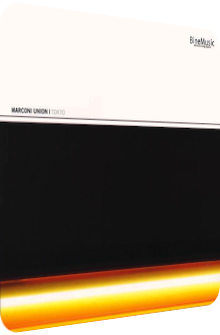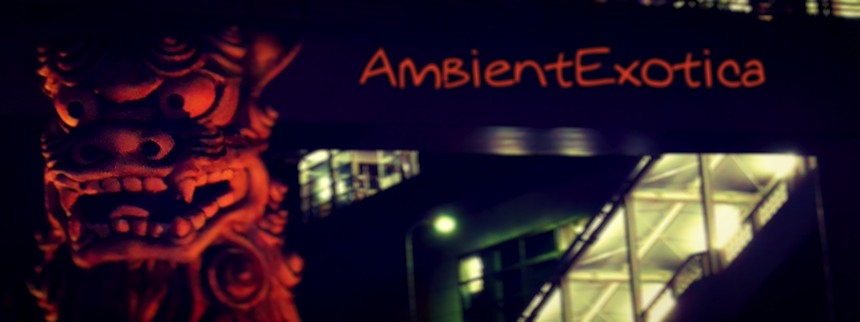
Marconi Union
Tokyo
2009
In 2010, Marconi Union decided to form a trio, then consisting of Richard Talbot, James Crossley and Duncan Meadows. Their strictly limited Tokyo of 2009 was the last album Talbot and Crossley did as a duo. 600 copies have been published on CD, but the album is fortunately available on iTunes, Amazon and co. If you follow the Ambient review section closely, you know that I am digging Japanese Ambient productions quite much. Here we have a British duo that produced a declaration of love for the dynamic and hyper-bustling city of Tokyo. Naturally, the album is a 100% electronic effort as all 7 tracks concentrate on the neon nightlife and city-related peculiarities. The mood is sometimes dystopian because there are majestically dark sections to be found in some of the tracks. But even in its brightest moments, Tokyo isn‘t a jocund ride but a gloomy and hypnotic affair with swirling synthscapes and electrifying bass droplets.
Ginza District is a dubby track with a definite focus on percussion, electronic claves and frosty snares. A minimal and relatively bright synth melody is added, but it is too weak and cannot overcome the dominance of the percussion. No favorite of mine, I‘m sorry to say, but it sets the dark, lively mood and fits with the overarching concept and is thus no foreign substance in this album. I just wished for a more Ambient structure with gentler drums. Lucky me, as I get exactly that on the following 4-minute long Lost In Neon with its vibrating dubs, clicking percussion, echoey background creaks and wonderful icy chimes. Some of the background synths are quite warm, but they always fade-out abruptly and wait for another swell. What works so great is the idea of space. The reverb and sustain of each ingredient is quite high, and this is hence no dry, immediate song but a thoroughful construction of a hollow sphere which is then filled with fragile clicks, synth sweeps and warm basslines. I like this piece way better than the first one. Nightworker is a terrific, frowningly dark and calm piece with growling synth strings and a melancholic, minimal melody on synth pads. In captures the mood of an office at night where one guy is working overtime. Whereas Lost In Neon is echoey, the aural room that is built by Nightworker is much smaller and cozier. The darkly droning synths work great, and when the stomping 4/4 beat sets in with the glacial percussion, the mood gets even more threatening. The whole song is a reminiscence to dark synth pop songs and Ambient releases of the 80‘s.
Hatsunori spends no time with long introductions and almost immediately adds an especially large beat with echoey clangs, short acid noises and a gorgeous, monotonous synth string that is slightly modulated. This is a powerful song and the focus on the various chimes and occasionally cacophonous sounds brings back the Microhouse feeling of the late 90‘s. Even though this is not strictly Ambient, the soothing background synth strings work well and add a peaceful counterpart to the beats. Red Line 12am starts with monotonous, vault-like synths and the incisively mechanical but mellow screeches that remind me time and again of Global Communication‘s 76:14. Gentle pulses of toms are added. It is only then that the listener is able to realize another echoey piece with an added wideness. The steady 4/4 beat which is added later is tremendously effective this time, as it doesn‘t dominate the mix but works on the same layer and fits perfectly with each addition. The mood is that of a foggy midnight with entrancing strings and short but deliciously polyphonous synth pad bursts. Red Line 12am is curiously repulsing and yet welcoming. The best song on the album, I think. Akihabara (Electric Town) is a dub monster with the superimposition of thumping bass drops, scintillating synth pads and soft percussion. The atmosphere is placid and surprisingly warm, even though there is no specific synth that can be pinpointed as the source of hotness. Temperature Drop is the final piece and presents the juxtaposition of soporific synth strings and menacingly dark percussion with drops of oscillating acid hooks and raspy hi-hats, making this one last remote song whose effects depend on the viewpoint of the listener: it is both melancholic and mesmerizing due to the ebb and flow of the synth strings which are indeterminably warm but also eerie.
The Marconi Union does a terrific job of giving me a hard time; the mood of their songs is neither joyful at all, nor is it completely dark and threatening. One thing is clear, though: the bustling atmosphere of this megacity isn‘t perceptible in their songs. In fact, the duo offers a hypnotizing view on the subject and evoke the feeling of isolation on the one hand and utter concentration on the other. The wideness in a lot of songs is clarified through echoes, reverbs and sustains, and wideness is a music-related device that is usually not taken into consideration when an artist tries to come up with a tokyoite feeling. Whereas Meguro by Takashi Wada is a colorful, soothing and relaxingly bright album, Marconi Union are on the opposite side of the spectrum, and Tokyo is hence more similar to the darkest work of Gas, Königsforst. The beats are either dubby or stringently club-oriented and always dominant, while the percussion is incessantly frosty, so if you like your Ambient music to be pristine with inklings of beats and percussion, you should probably avoid this album. However, the dark and distinct, yet mesmeric mood is definitely appealing and the album as a whole is perfectly balanced.
Ambient Review 029: Marconi Union – Tokyo (2009). Originally published on Feb. 1, 2012 at AmbientExotica.com.
